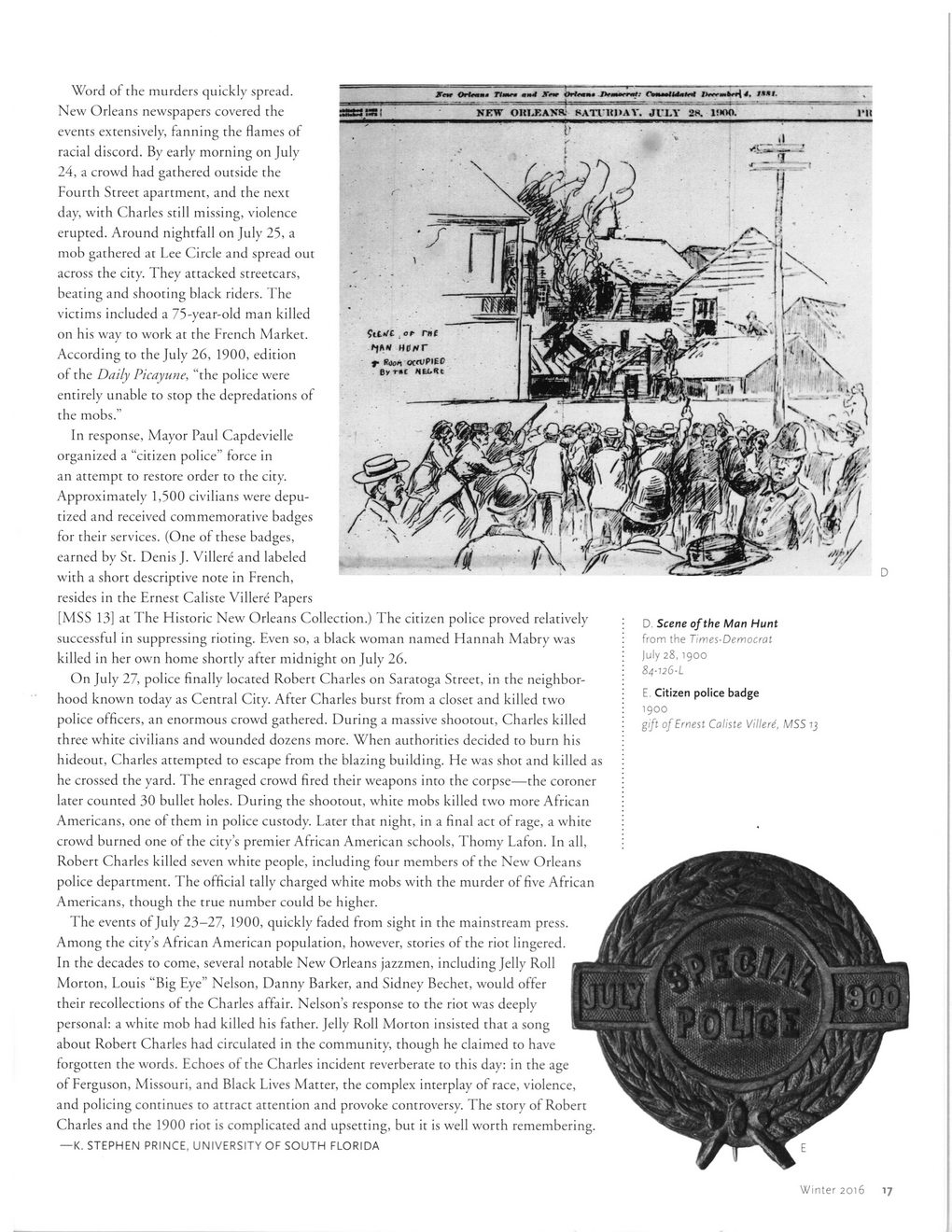This text was obtained via automated optical character recognition.
It has not been edited and may therefore contain several errors.
Sew Oriemma Tim seta ski Word of the murders quickly spread. New Orleans newspapers covered the events extensively, fanning the flames of racial discord. By early morning on July 24, a crowd had gathered outside the Fourth Street apartment, and the next day, with Charles still missing, violence erupted. Around nightfall on July 25, a mob gathered at Lee Circle and spread out across the city. They attacked streetcars, beating and shooting black riders. The victims included a 75-year-old man killed on his way to work at the French Market. According to the July 26, 1900, edition of the Daily Picayune, “the police were entirely unable to stop the depredations of the mobs.” In response, Mayor Paul Capdevielle organized a “citizen police” force in an attempt to restore order to the city. Approximately 1,500 civilians were deputized and received commemorative badges for their services. (One of these badges, earned by St. Denis J. Villere and labeled with a short descriptive note in French, resides in the Ernest Caliste Villere Papers [MSS 13] at The Historic New Orleans Collection.) The citizen police proved relatively successful in suppressing rioting. Even so, a black woman named Hannah Mabry was killed in her own home shortly after midnight on July 26. On July 27, police finally located Robert Charles on Saratoga Street, in the neighborhood known today as Central City. After Charles burst from a closet and killed two police officers, an enormous crowd gathered. During a massive shootout, Charles killed three white civilians and wounded dozens more. When authorities decided to burn his hideout, Charles attempted to escape from the blazing building. He was shot and killed as he crossed the yard. The enraged crowd fired their weapons into the corpse—the coroner later counted 30 bullet holes. During the shootout, white mobs killed two more African Americans, one of them in police custody. Later that night, in a final act of rage, a white crowd burned one of the city’s premier African American schools, Thorny Lafon. In all, Robert Charles killed seven white people, including four members of the New Orleans police department. The official tally charged white mobs with the murder of five African Americans, though the true number could be higher. The events of July 23-27, 1900, quickly faded from sight in the mainstream press. Among the city’s African American population, however, stories of the riot lingered. In the decades to come, several notable New Orleans jazzmen, including Jelly Roll Morton, Louis “Big Eye” Nelson, Danny Barker, and Sidney Bechet, would offer their recollections of the Charles affair. Nelson’s response to the riot was deeply personal: a white mob had killed his father. Jelly Roll Morton insisted that a song about Robert Charles had circulated in the community, though he claimed to have forgotten the words. Echoes of the Charles incident reverberate to this day: in the age of Ferguson, Missouri, and Black Lives Matter, the complex interplay of race, violence, and policing continues to attract attention and provoke controversy. The story of Robert Charles and the 1900 riot is complicated and upsetting, but it is well worth remembering. —K. STEPHEN PRINCE, UNIVERSITY OF SOUTH FLORIDA > mnd JTnr TSemmmtt: Cmn^Hdrntr* 4, /Ml. NEW OiUJ?AK» 8ATT1U>AY. JVLY 28, l«IOO. vn D. Scene of the Man Hunt from the Times-Democrat July 28, 1900 84-126-1 E Citizen police badge 1900 gift of Ernest Caliste ViHeri, MSS 13 \ -Vs; /Mmk Winter 2016 17

New Orleans Quarterly 2016 Winter (19)